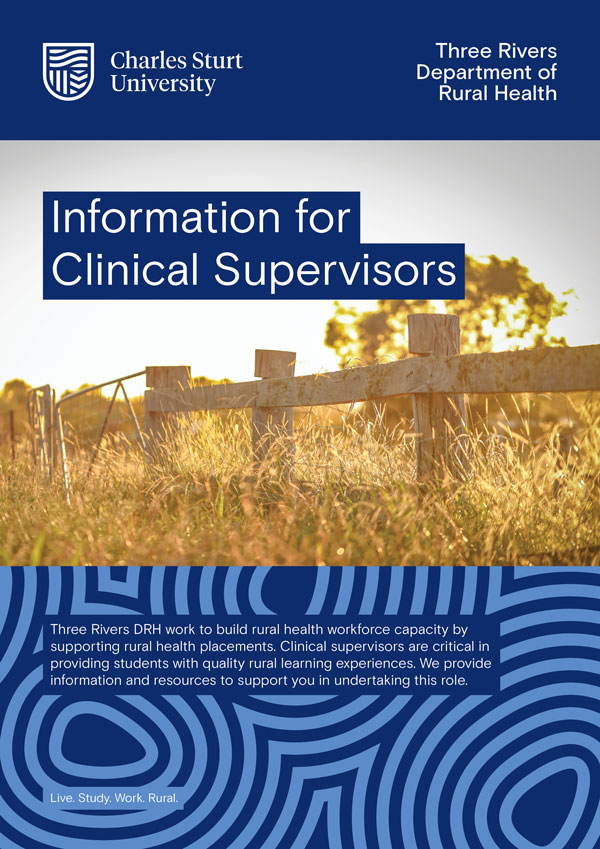Information for supervisors
We work to build rural health workforce capacity by supporting rural health placements. Clinical supervisors are critical in providing students with quality rural learning experiences. We provide information and resources to support you in undertaking this role.
Download a copy of our Information for Clinical Supervisors booklet.
-
Information for clinical supervisors chevron_right
What is supervision?
Placements are a mandatory requirement for health degrees which provide students the opportunity to integrate theory into practice and develop clinical, critical thinking, and problem-solving skills. Supervision is one of the key mechanisms for facilitating learning and helps to ensure high quality and safe patient care during placement. Modes of supervision vary in accordance with the disciplines’ accreditation requirements, but usually includes educational, supportive, and administrative functions.
Modes of supervision:
- Individual supervision – one supervisor and one supervisee in a private session for reflection and learning.
- Peer supervision – an informal setting with peers at an equivalent clinical level providing each other with support and feedback in a reciprocal process. Differing from traditional supervision modes as there is no ‘expert’ i.e., supervisor, present.
- Group supervision – one supervisor facilitating discussion with two or more supervisees to allow learning from each other’s experiences.
For further information please refer to our online learning module on this topic, Module 1: Introduction to Supervision.
The supervisor-student relationship
As a supervisor, you will play a leading role in the education and training of students. The student is there to learn from you. Your role is to guide the student in the application of their clinical skills, observe them interacting with patients, and provide constructive feedback on their performance. When establishing a relationship with your supervisee it is important to ensure from the very beginning that both parties have clear expectations of the process. Provide examples of what learning is expected of students throughout the placement, how they can demonstrate it, and importantly you must provide them with the opportunities to demonstrate it.
For further information please refer to our online learning module on this topic, Module 3: Creating A Best Practice Clinical Learning Environment.
Rural health placements
Placement in a rural health setting differ from that of their urban counterparts in many ways including modes of service delivery, managing boundaries, and needs versus available resources. They are unique and come with challenges however they also produce a great sense of community, job satisfaction and fulfillment. Supervising a rural health placement is rewarding as you are not only showcasing your chosen career to students but your chosen way of life and town. Remember that in growing our own we aim to enhance the rural experience for the students we supervise.
For further information please refer to our online learning module on this topic, Module 2: Enhancing the Rural Experience.
Creating a positive placement experience
The first day of placement sets the tone for the student. Make sure they feel welcomed by providing a sound orientation including but not limited to a tour of your organisation and introduction to all staff. Discuss with the student the placement learning program, clarifying expectations, workplace policies and procedures, and the cultural norms and practices within your organisation. It can be helpful to provide students with a written timetable for their first week including any meetings with different teams and/or professionals with whom they may interact with. Schedule supervision sessions into this timetable right from the start and ensure you regularly communicate your availability.
For further information please refer to the following resources on this topic, Promoting a positive learning environment and Chapter 2: Student orientation.
Providing feedback
Providing feedback on performance is essential to learning. In your first supervision session introduce and define the process of feedback with your student so they understand its purpose, intended delivery, and the expectations of them to action it as required. For feedback to be embraced by a student, a supervisor needs to first ensure psychological safety and a strong educational alliance. It needs to be relevant, individualised, and based on observations. At times, providing feedback will mean communicating to a student that their performance is unsatisfactory, addressing unprofessional behaviour, and discussing sensitive issues. These challenging conversations usually involve intense emotions, differing opinions, a power imbalance, and uncertainty about outcomes. It is important that these conversations are not avoided but instead dealt with as soon as possible.
For further information please refer to our online learning module on this topic, Module 5: Challenging Conversations.
Supports
The Three Rivers Rural Health Education Team provide information and ‘on the ground’ support for supervisors working within our footprint. Make sure you contact your local Three Rivers Clinical Educator to support you in supervising students. You can also refer to our online learning module on this topic, Module 6: Self-Care for Clinicians.
Workplace Learning teams at each university can help both supervisors and students; contact them early if issues arise or when students are performing below expectations. They’re able to provide you with resources, tools, and guides to support you as a supervisor, and guide you in the use of any discipline specific assessment and reporting tools.
Counselling services are available to students through their university which you can encourage students to access as needed. Students can also access the following resources:
Rural Placement Guide, National Rural Health Student Network
Mental Health Guide – When the Cowpat Hits the Windmill, National Rural Health Student Network
Resources
More information about our people, locations, placement models, student support, clinical supervision training, and professional development opportunities is available on this website.
Learn about our Rural Health Education workstream
Contact our Rural Health Education team
Further resources:
The Wiley International Handbook of Clinical Supervision
Clinical Supervision Handbook, Government of Western Australia Drug and Alcohol Office
The SuperGuide: A Handbook for Supervising Allied Health Professionals
The SuperGuide: A Supervision Continuum for Nurses and Midwives
ClinEdAus
Best Practice Clinical Learning Environment (BPCLE) Framework Resource
National Placement Evaluation Centre

